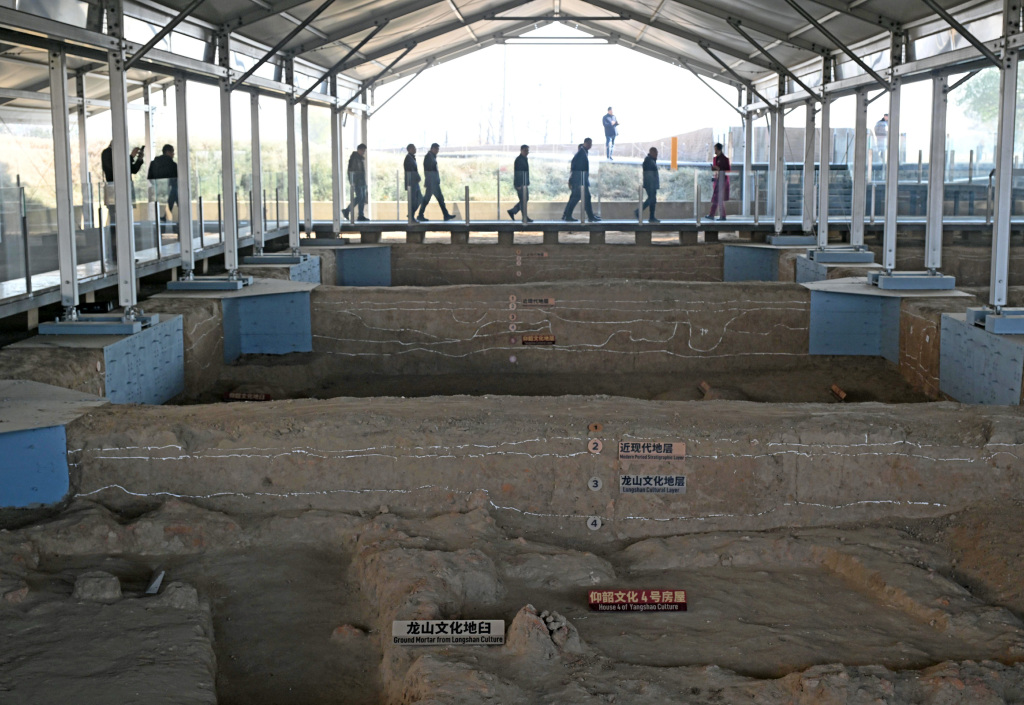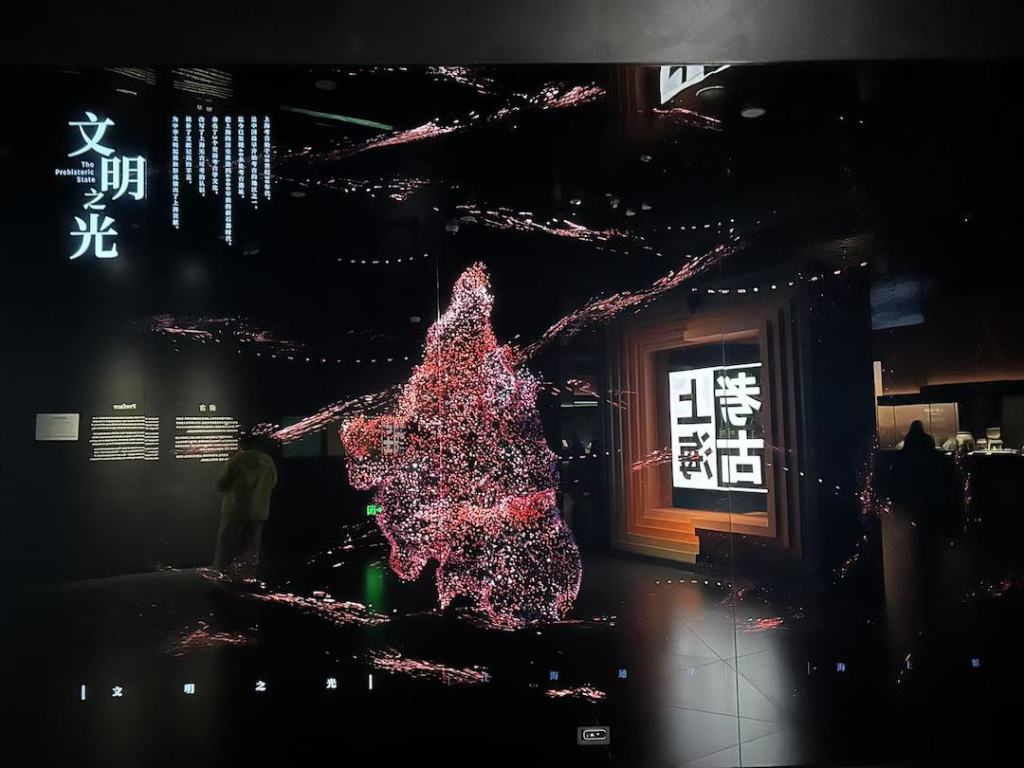
The mighty Yangtze River emerges from the Qinghai-Tibet Plateau, passes through high mountains and canyons, flows over steep ridges and dangerous shoals, travels through the water towns of Jiangnan, and finally reaches the sea at Shanghai, embracing numerous rivers, thus becoming vast and grand.
Culture is like water, silently permeating; civilization is like a tide, the sound of the river resounding.
With guidance and coordination from the News Bureau of the Publicity Department of the Communist Party of China and the New Media Professional Committee of the China Journalists Association, The Paper has collaborated with major media from 13 provinces (regions, municipalities) along the Yangtze Economic Belt to launch the special report titled "Cultural Journey in China | The Song of the Yangtze" - "Tracing Up the River." This initiative reports on Yangtze culture by moving upstream from the lower reaches of the river. This issue focuses on the 6,000-year-old Songze archaeological site located in Qingpu, Shanghai.

An archaeological photo of the Songze site from the 1960s
When mentioning "the first person of Shanghai" and "the first house of Shanghai," these names are closely related to the 6,000-year-old Songze site.
In Zhaoxiang Town, Qingpu District, Shanghai, the Songze Village quietly stands as a museum that narrates the origins of Shanghai's history, amid farmland and rivers—the Shanghai Songze Site Museum. The museum's structure is modest, with heights that fluctuate, resembling silhouettes of an ancient village, perfectly blended into the cultural and natural landscape of the Jiangnan water towns.
Discovered in 1957, the Songze site marked the beginning of over half a century of excavation, protection, and research. It is one of the earliest large-scale scientific archaeological sites in Shanghai, pushing the history of Shanghai back to 6,000 years ago. The Songze Site Museum, as the first prehistoric site museum established at its original location in Shanghai, serves as an important window for showcasing the Songze site and allows the public to understand Shanghai's history from 6,000 years ago and to inherit the cultural thread connecting ancient and modern Shanghai.

Exterior view of the Shanghai Songze Site Museum
Searching for the tomb of Yuan Song from the Eastern Jin Dynasty unexpectedly led to the discovery of the Songze site
Located in the typical rice and fish region of Jiangnan, Songze Village in Qingpu District is surrounded by a network of rivers and fields, a landscape that reflects the current ecology around the Songze Site Museum. Situated along the Huqingping Highway, the Shanghai Songze Site Museum appears modest and welcoming, nestled among farmland, green spaces, and rivers. The building’s exterior layout, marked by varied elevations, mirrors that of ancient villages.
In earlier years, there was a saying in the archaeological community that "Shanghai has no ancient relics." Veteran archaeologists often pondered how to excavate on asphalt roads. The discovery of the Songze site in 1957 ended this notion and initiated a long archaeological journey at the site.
The first archaeologists to conduct surveys in Qingpu County (now Qingpu District) were Mr. Huang Xuanpei, former deputy director of the Shanghai Cultural Heritage Administration and the Shanghai Museum, and Mr. Sun Weichang, former deputy director of the Archaeology Department at the Shanghai Museum. According to oral accounts from Mr. Huang and Mr. Sun, their primary focus was on Fubao Mountain and the Songze area due to a local historical record mentioning a garden mound in Songze where the tomb of Yuan Song was purportedly located.
“We were interested in whether this could be a tomb from the Jin Dynasty; at the time of our investigation, it was still said that Shanghai had no ancient relics. Even having traces from over 1,600 years ago was quite impressive,” Mr. Huang stated. “Mr. Huang Xuanpei and I were eager to explore Qingpu and eventually discovered this ancient cultural site, Songze,” Mr. Sun recounted.
In 1961 and 1974, the Shanghai archaeological team, led by Mr. Huang Xuanpei, conducted planned excavations at the site. Archaeological findings demonstrated that the Songze site spanned from the Neolithic to the early Warring States periods. They discovered remains of the Majiabang culture and what later became known as the Songze culture.

Panoramic view of the Songze site in the 1980s
Based on these archaeological results, in 1987, the Shanghai Municipal Cultural Heritage Administration compiled and published the book "Songze: Excavation Report of a Neolithic Site," marking Shanghai's first formal archaeological monograph, with the title inscribed by Jiang Zemin, then secretary of the Shanghai Municipal Committee. It was also on the foundation of these two excavations that the naming of "Songze Culture" gained widespread recognition, becoming the first archeological culture named after a place in Shanghai. Successive generations of Shanghai archaeologists have built upon this, enriching the cultural connotation of this ancient cultural site.
Researcher Zhang Minghua from the Shanghai History Museum, who participated in the excavation of the Songze site, told The Paper that the site has accumulated over 6,000 years of Majiabang culture, 5,000–6,000 years of Songze culture, over 4,000 years of Liangzhu culture, along with sporadic remains from the Western Zhou and Spring and Autumn periods; at its heart lies a large cemetery containing more than a hundred ancient tombs from 5,000–6,000 years ago. Among the findings were the earliest human remains, the earliest house, the first pot of meat (dating back over 6,000 years), a stone tool manufacturing site (over 5,000 years ago), and notably, the earliest water well, the first cultivated strains of japonica and indica rice, the first domesticated pigs, and even the earliest jade artifacts.

Ceramic depiction of a domesticated pig
“The Songze site may not be very distinguished; it should be considered an ordinary prehistoric village, but it showcases the production and lifestyle scenes of ancient inhabitants on this land. Moreover, the discovery of Songze culture fills in the gap between Majiabang culture and Liangzhu culture, laying a solid foundation for Liangzhu civilization to reach a peak in prehistoric Chinese civilization,” said Song Jian, former head of the Archaeology Department at the Shanghai Museum. He was also the earliest discoverer of "Shanghai's first well" during the excavation of the Songze site.

Notched ceramic vessel

Double-layer perforated petal-foot ceramic pot
"Archaeologists believe that the Songze culture represents a distinctive, intellectually vibrant period. For instance, the pottery of Songze culture is diverse and creatively shaped, indicating that the foundation for civilization began during this stage. Songze culture is the beginning of civilization, and its influence extends throughout the Taihu Lake region and even into the lower reaches of the Yangtze River," said Song Jian.

Aerial view of the excavation area in 2014
Over the past decade, excavation, protection, and research efforts at the Songze site have continued. According to Huang Xiang, head of the Archaeology Research Department at the Shanghai Museum, archaeological work at the Songze site has entered its third phase, with effective protection, display, and utilization of the site. "In 2014, the Shanghai Songze Site Museum officially opened to the public, marking a new stage for the exhibition and utilization of the Songze site. By 2018, we had completed comprehensive archaeological surveys of the Songze site; by 2021, it became the only ancient site in Shanghai selected as one of the top 100 archaeological discoveries in a century."
Exploration from Site to Museum
Songze Village, where the site is located, is a typical Jiangnan region known for its rice production and fishing, surrounded by a network of rivers and fields, a landscape that still reflects the current ecology around the Songze Site Museum.

Stele marking the Songze site as a National Key Cultural Relic Protection Unit
Walking past the stele that marks the Songze site as a "National Key Cultural Relic Protection Unit" (In 2013, the State Council designated it as the seventh batch of National Key Cultural Relic Protection Units), standing on the stone bridge leading to the site museum, you can see a winding narrow river flowing east-west below. The riverbank remains untouched, and in the autumn and winter seasons, patches of reeds extend along the river. The scene before you sparks the imagination, and the land beneath your feet is where the early inhabitants of Shanghai farmed and hunted; over 6,000 years of change seems to have occurred in an instant.

Shanghai Songze Site Museum
The Songze Site Museum was built directly on the original excavation site, situated within the core area of the Songze site, where the tombs, along with "Shanghai’s first person" and "Shanghai's first house," were excavated. While the entire protected area of the Songze site covers about 150,000 square meters, the museum occupies only about one-tenth of that space. The Songze Site Museum can be considered the only place where the public can witness and reminisce about the scenes of the Songze archaeological discovery.

The small river in front of the Shanghai Songze Site Museum
The Shanghai Songze Site Museum was initiated in 2003 as a major cultural facility construction project during Shanghai's 12th Five-Year Plan. After more than ten years of preparation and construction, it officially opened to the public on May 18, 2014. As a branch of the Shanghai History Museum (Shanghai Revolutionary History Museum), it is positioned for "site protection management, collection of excavated artifacts, academic research, local history education, and cultural leisure tourism," committed to preserving and safeguarding Shanghai's history.

Exterior view of the Shanghai Songze Site Museum
Twenty years ago, building a museum directly on the site was considered a forward-thinking concept that faced some controversy at the outset, as it is not traditionally considered a "site museum," since it does not display the site itself.
According to Zhang Lan, former director of the Shanghai History Museum, when the Songze Site Museum was first constructed, there were


